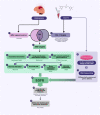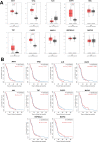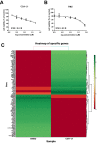Identification of potential targets of the curcumin analog CCA-1.1 for glioblastoma treatment : integrated computational analysis and in vitro study
- PMID: 35977996
- PMCID: PMC9385707
- DOI: 10.1038/s41598-022-18348-9
Identification of potential targets of the curcumin analog CCA-1.1 for glioblastoma treatment : integrated computational analysis and in vitro study
Abstract
The treatment of glioblastoma multiforme (GBM) is challenging owing to its localization in the brain, the limited capacity of brain cells to repair, resistance to conventional therapy, and its aggressiveness. Curcumin has anticancer activity against aggressive cancers, such as leukemia, and GBM; however, its application is limited by its low solubility and bioavailability. Chemoprevention curcumin analog 1.1 (CCA-1.1), a curcumin analog, has better solubility and stability than those of curcumin. In this study, we explored potential targets of CCA-1.1 in GBM (PTCGs) by an integrated computational analysis and in vitro study. Predicted targets of CCA-1.1 obtained using various databases were subjected to comprehensive downstream analyses, including functional annotation, disease and drug association analyses, protein-protein interaction network analyses, analyses of genetic alterations, expression, and associations with survival and immune cell infiltration. Our integrative bioinformatics analysis revealed four candidate targets of CCA-1.1 in GBM: TP53, EGFR, AKT1, and CASP3. In addition to targeting specific proteins with regulatory effects in GBM, CCA-1.1 has the capacity to modulate the immunological milieu. Cytotoxicity of CCA-1.1 was lower than TMZ with an IC50 value of 9.8 μM compared to TMZ with an IC50 of 40 μM. mRNA sequencing revealed EGFR transcript variant 8 was upregulated, whereas EGFRvIII was downregulated in U87 cells after treatment with CCA-1.1. Furthermore, a molecular docking analysis suggested that CCA-1.1 inhibits EGFR with various mutations in GBM, which was confirmed using molecular dynamics simulation, wherein the binding between CCA-1.1 with the mutant EGFR L861Q was stable. For successful clinical translation, the effects of CCA-1.1 need to be confirmed in laboratory studies and clinical trials.
© 2022. The Author(s).
Conflict of interest statement
The authors declare no competing interests.
Figures







Similar articles
-
Afatinib and Temozolomide combination inhibits tumorigenesis by targeting EGFRvIII-cMet signaling in glioblastoma cells.J Exp Clin Cancer Res. 2019 Jun 18;38(1):266. doi: 10.1186/s13046-019-1264-2. J Exp Clin Cancer Res. 2019. PMID: 31215502 Free PMC article.
-
Exploring the therapeutic mechanisms and prognostic targets of Biochanin A in glioblastoma via integrated computational analysis and in vitro experiments.Sci Rep. 2024 Feb 15;14(1):3783. doi: 10.1038/s41598-024-53442-0. Sci Rep. 2024. PMID: 38360888 Free PMC article.
-
Combination Therapy with Nanomicellar-Curcumin and Temozolomide for In Vitro Therapy of Glioblastoma Multiforme via Wnt Signaling Pathways.J Mol Neurosci. 2020 Oct;70(10):1471-1483. doi: 10.1007/s12031-020-01639-z. Epub 2020 Jul 14. J Mol Neurosci. 2020. PMID: 32666415
-
Anticancer Mechanism of Curcumin on Human Glioblastoma.Nutrients. 2021 Mar 16;13(3):950. doi: 10.3390/nu13030950. Nutrients. 2021. PMID: 33809462 Free PMC article. Review.
-
Targeting EGFR for treatment of glioblastoma: molecular basis to overcome resistance.Curr Cancer Drug Targets. 2012 Mar;12(3):197-209. doi: 10.2174/156800912799277557. Curr Cancer Drug Targets. 2012. PMID: 22268382 Free PMC article. Review.
Cited by
-
Potential of Curcumin and Its Analogs in Glioblastoma Therapy.Antioxidants (Basel). 2025 Mar 18;14(3):351. doi: 10.3390/antiox14030351. Antioxidants (Basel). 2025. PMID: 40227413 Free PMC article. Review.
-
Discovery of pyroptosis-inducing natural products in neuroblastomas: computational studies with experimental validation.BMC Complement Med Ther. 2025 Jul 19;25(1):279. doi: 10.1186/s12906-025-05004-8. BMC Complement Med Ther. 2025. PMID: 40684133 Free PMC article.
-
Expression of molecular markers and synergistic anticancer effects of chemotherapy with antimicrobial peptides on glioblastoma cells.Cancer Chemother Pharmacol. 2024 May;93(5):455-469. doi: 10.1007/s00280-023-04622-8. Epub 2024 Jan 27. Cancer Chemother Pharmacol. 2024. PMID: 38280033
-
Citrus flavonoids for overcoming breast cancer resistance to methotrexate: identification of potential targets of nobiletin and sinensetin.Discov Oncol. 2025 Mar 20;16(1):365. doi: 10.1007/s12672-025-02116-y. Discov Oncol. 2025. PMID: 40111633 Free PMC article.
-
Potential of Natural Products in the Treatment of Glioma: Focus on Molecular Mechanisms.Cell Biochem Biophys. 2024 Dec;82(4):3157-3208. doi: 10.1007/s12013-024-01447-x. Epub 2024 Aug 16. Cell Biochem Biophys. 2024. PMID: 39150676 Review.
References
Publication types
MeSH terms
Substances
LinkOut - more resources
Full Text Sources
Medical
Molecular Biology Databases
Research Materials
Miscellaneous

